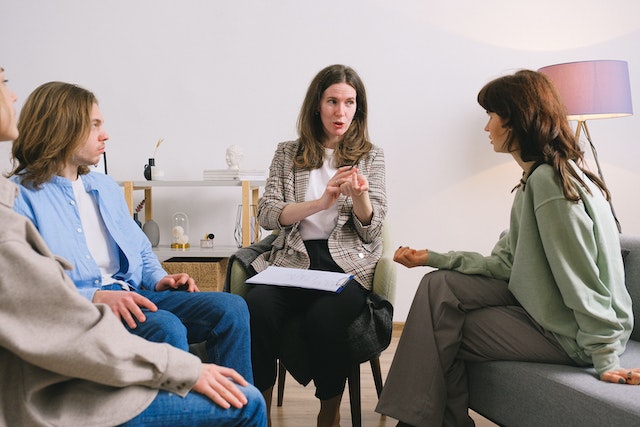 The relationships that the patients establish with the therapist and the other group members will recreate, in one way or another, the primitive relationships of the patient with his nuclear relative. For example, a male patient with an authoritarian father may view the therapist (a male of similar age to his father) as rigid and restricting the group’s freedom, as he thinks his father would. Or a female patient whose parents were negligent in caring for her in childhood may feel abandoned or rejected by the other group members when they do not ask her how she is after a day away sick. The therapist’s mission is to recapitulate these scenarios correctly, in addition to encouraging patients to experience new behaviours and find an explanation for the old ones.
The relationships that the patients establish with the therapist and the other group members will recreate, in one way or another, the primitive relationships of the patient with his nuclear relative. For example, a male patient with an authoritarian father may view the therapist (a male of similar age to his father) as rigid and restricting the group’s freedom, as he thinks his father would. Or a female patient whose parents were negligent in caring for her in childhood may feel abandoned or rejected by the other group members when they do not ask her how she is after a day away sick. The therapist’s mission is to recapitulate these scenarios correctly, in addition to encouraging patients to experience new behaviours and find an explanation for the old ones.
Existential factors
In therapy groups geared towards helping people with chronic illnesses, such as cancer, or in bereavement groups, these existential factors (such as talking about death or the meaning of life) sometimes play a central role in therapy. In group therapy for addictions, it has been seen that the meaning of life is a very important factor to consider when working with addicts. Many patients have gone through very difficult situations, and the addiction has been able to truncate their plans and life expectations. Recovering or giving meaning to their lives can be very important in the face of their recovery.
Group cohesion
Group cohesion is for group therapy, as the therapist-patient relationship is for individual therapy. A cohesive group is one in which its members accept and support each other and form meaningful relationships among its participants. Cohesive groups achieve better therapeutic results than non-cohesive groups (Budman et al., cited in Vinogradov and Yalom, 2010). It is common for people who suffer from serious addictions to go years without feeling like a valued group member, so this group experience can be therapeutic. In addition, it lays the foundations for establishing similar relationships, of cohesion and integration, in other social groups outside of therapy and thus, expanding the social circles of the members of the therapeutic group.
Group cohesion favours acceptance and understanding among group members. This, in turn, facilitates emotional expression and candour among group members. Sincerity will be a source of feedback so that each member becomes aware of aspects of her personality that she may want to change.
Interpersonal learning
Interpersonal relationships contribute to personality development and are involved in the origin of psychopathology and current symptoms. Each group member’s current problems are greatly influenced by their interpersonal relationships. The same relationship problems that each individual has outside the group will begin to manifest, sooner or later, in the group. If the group offers its members a safe and sincere environment, this will help those interpersonal interactions that take place within the group become corrective emotional experiences.
So powerful is the interaction that can be observed between the members of the group that it is hardly necessary for the patients to report current difficulties or recount their past. The very interpersonal interaction observed in the therapeutic group can provide this information to therapists.
The corrective emotional experience within the group therapy allows us to take out of the therapy to the daily life what was learned in it. Putting these newly learned behaviours into practice favours the integration and assimilation of these experiences. Finally, the patient can realize her potential to change his way of being, behaving, reacting, etc and acquire, therefore, greater self-efficacy.
The group psychotherapist
Usually, the therapeutic group is led by a main therapist who is assisted by a co-therapist. The therapist also has an active role in therapy. Both of you must be neutral, sincere, flexible and understanding; In addition, they must avoid situations during the sessions where there may be disqualifications among the group members. The fact that there are two therapists has great advantages compared to only one (Fernandez et al., 2007):
- The continuity of the group if one of the two therapists cannot attend.
- The possibility of one of the two dealing with an interpersonal conflict between two patients or taking care of a particular patient or group of patients who may engage in more hostile or disruptive behaviour.
- At the end of the therapeutic session, both therapists can meet to discuss what happened that day in the group and plan the following sessions. “Four eyes see more than two”.
 Therapists are responsible for favouring a group climate of respect, collaboration, understanding and active participation of everyone who makes it up. To achieve this climate, the therapist must have specific training in psychotherapy and, specifically, in group psychotherapy, must gather clinical experience and have a deep knowledge of the disease that the patients share (in this case, addiction).
Therapists are responsible for favouring a group climate of respect, collaboration, understanding and active participation of everyone who makes it up. To achieve this climate, the therapist must have specific training in psychotherapy and, specifically, in group psychotherapy, must gather clinical experience and have a deep knowledge of the disease that the patients share (in this case, addiction).
The therapist is expected to have certain personal skills and aptitudes: to be trustworthy, even-tempered, empathetic to others, to have a good sense of humour (without going overboard), and to have a strong sense of self. His participation during group therapy sessions has to be active, helping group members to maintain the focus of treatment within a structure and norms established in the group’s therapeutic contract. In this way, the group therapist maintains the cohesion and stability of the group. The therapist often relies heavily on the “here and now” to help patients overcome the painful consequences of addictive disorders, such as psychosocial problems, medical illnesses, and associated mental disorders (Brook, 2011).
A group therapist has to pay particular attention to the following aspects of treatment (Brook, 2011):
- The adequate selection of patients for each group.
- The preparation of the group members before starting the group sessions.
- The establishment and maintenance of a structure and security for the group.
- The use of constructive confrontation during the therapeutic process of the group.
- The specific intervention of the group therapist
.Group therapies for patients who are in different phases of their addiction
Patients in an active consumption phase would not benefit from a relapse prevention group. Other types of groups are recommended for these patients. Host groups or abstinence preparation groups are often offered. It has different objectives and different structures.
On the other hand, in some patients in whom absolute abstinence has not been possible, harm reduction group therapy may be offered. The main objective is not abstinence but reducing consumption to minimize or reduce the physical, social, family, personal and economic consequences of consumption on the patient. Once they have reduced consumption, are exposed to fewer risk situations and have seen their quality of life partially improve by reducing consumption, they decide to seek a more ambitious goal: absolute abstinence.
Group therapies for homogeneous populations
Certain populations, such as adolescents, the elderly, abused women, people from minority ethnic groups, and immigrants who speak other languages or from other cultures, may benefit from specific groups. These groups with greater homogeneity among their members allow greater group cohesion and specific issues inherent to their particular situation. For example, adolescents have concerns related to the stage of life they are in, such as their sexual development, their academic future, and romantic relationships.
